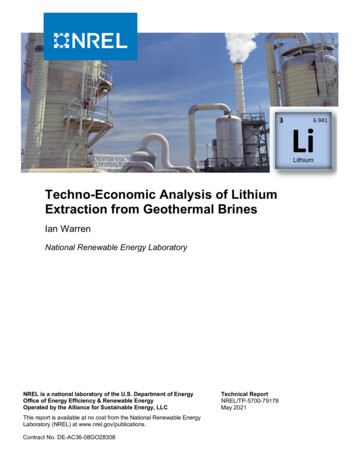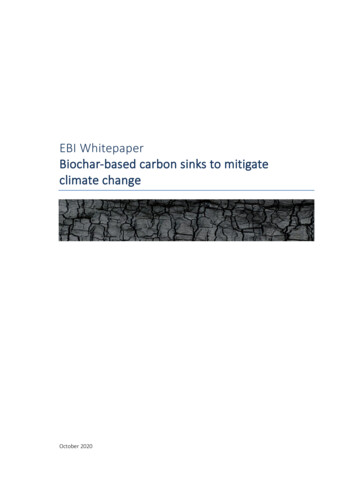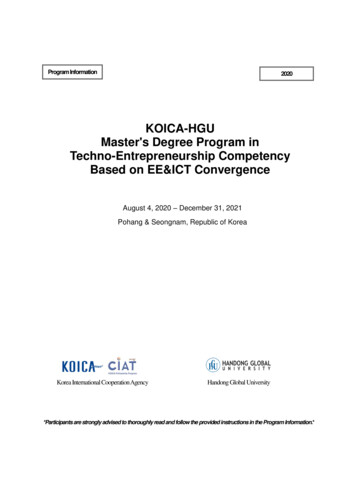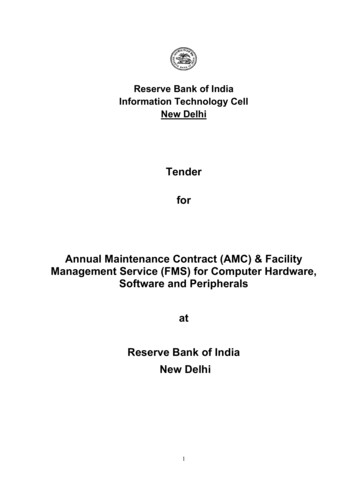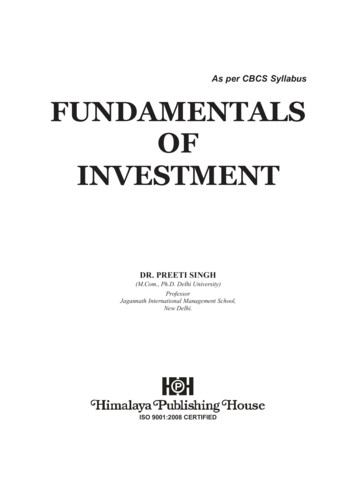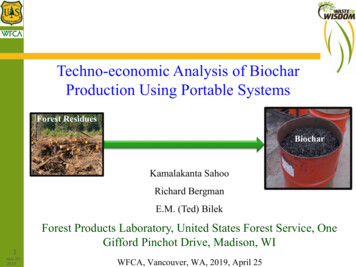
Transcription
Techno-economic Analysis of BiocharProduction Using Portable SystemsForest ResiduesBiocharKamalakanta SahooRichard BergmanE.M. (Ted) Bilek1April 27,2019Forest Products Laboratory, United States Forest Service, OneGifford Pinchot Drive, Madison, WIWFCA, Vancouver, WA, 2019, April 25
Forest Products Laboratory and Research Priorities Founded in 1910 by the U.S. ForestService and located in Madison, WI The Nation’s source for unbiasedwood research and technicalinformation A long history of cooperativeresearch and public service Advanced Composites Advanced Structures Forest Biorefinery2April27, Nanotechnology Woody Biomass Life cycle assessment andtechno-economic analysis offorest based products Supply chain modeling,simulation and optimization
Biochar market: Present and FutureBiochar Market and policies: Biochar companies rose from 200 in 2014 to 326 companies in 2015 3.1 billion by 2025 with a CAGR of 13.2% (www.grandviewresearch.com) US biochar production- 94,000 tonnes in 2014 to 285,000 tonnes by 2025.3April 27,2019 35 US policies that support biochar production (15 are commercial financial incentives) Biochar price in the US varies between ( 1360-3864/ton)
Background: Why biochar?Piling residues: 150-200/hectareSite preparation: 750-2000/hectareAir quality issues, Wild firesBiocharSolid biofuelsScattered residues3April27, Require higher qualityfeedstock (less contamination,Piled residueslow moisture content, uniformsize, etc.)(81-116 million dry tons Large plant (high capitalof forest biomass)investment & risks, Higherlogistics cost, UncertaintiesLiquid biofuelsHeat and electricity
Objectives To analyze the economic feasibilities [i.e., estimate minimumselling price (MSP)] of portable biochar production systems at nearforest (remote sites) and in-town locations. To perform sensitivity analyses to identify critical factorsaffecting economic performances of portable systems and suggestimprovements.5April 27,2019
Biochar production using portable systemsOregon kiln (Wilson Biochar Associate)Forest residuesBiocharAir curtain burner6April 27,2019Woodchips/ground residuesBiochar Solution Inc. (BSI)
BSI portable systemIn forest operations(felling, yarding, loading/hauling biomass)Sorting/processingbranches and topsSorting/processingpulp ScreeningBiomassElectricity - Power PalletElectricity - Diesel generatorElectricity – Grid (In town only)Propane7April issionswith BSI systemHeatPackaging andtransportConsumer
Oregon kiln and Air burnersportable systemsAir curtain burnersOregon kilnIn forest operations(felling, yarding, loading/hauling biomass)In forest operations(felling, yarding, loading/hauling biomass)Sorting boles, branches, and topsProcessingsiteProcessingsiteBiomassFurther processing using chainsawsLoadingBiomassWater8April 27,2019BiocharDiesel production withOregon oductionPropane with Air burnerBiocharAshEmissions
Feedstocks specifications and system throughputComminutionSpecies ContaminantmethodMoisturecontentPortable system(wet basis)ThroughputBiochar(*kg/hr/unit) oryield .8%Conifer9% soilGround14.91%BSI*34111.7%ConifernoneChip, medium25.18%BSI*35110.5%ConifernoneChip, small20.66%BSI*26814.4%Conifer2/3 bole,1/3 topsGroundNoNo16.20%BSIOregon kilnAir curtain burner*434**45*10,00013.2%20%20%9April 27,2019
Critical assumptions for economic model No grants and subsidies included in this study Forest residues at no-cost 8 hours/day x 100 days of operations in a year (But BSI system withdrying unit can work all year with addition of feedstocks drying units) BSI system can be used to produce biochar at the near-forest and intown locations Oregon kiln and Air curtain burner used in-forest locations 2 BSI units or 12 Oregon kilns or 1 Air curtain burner for the base case 10 years economic life of the project10April27, 15% Required Returns on Invested Capital (ROIC), 2% inflation forcost and revenue, 6% loan interest rate, loan (40% of total capitalinvestment), etc. 40% income tax
Input data:Capital costs11April 27,2019Air burnerOregon KilnBSINo ionFront-end loaderBeltomatic 123BBiochar Solutions, 0.5Biochar machinesTonnes/hrGasifier-Gensets 20 kW, PP20GT gasifierDiesel-GensetDiesel generator, 40 kWBSI, TotalKilnOregon kilnShovelChain sawPropane torchSkidderCAT-70hpOregon Kiln, TotalAir curtainS-327burnerLoaderJohn Deere 2954DAir burner, TotalPurchase Economic Salvageprice( ) life (year) Value 0020169,0001020433,000 602,000102035,00040,000 955,0008505050030032,000 78,100
Input data:Operational costsDescriptionsUnitsBSIFeedstocks /tonne10-30--Relocations /site11,300500100010%10%2.03 l/batch-1.6 l/batch14.3 l/hr----26111Repair andmaintenance12April 27,2019% capital20%costPropane 0.54 l/hrConsumableDiesel /dryPackaging124.1tonneFinished good /dry52.0transportationtonneTechnician: 50.5/hr1Loader operator: 22.5/hrNon-skilled labor: 16.8/hr2Oregon Kiln Air BurnerCommentsChipping/grindingand transportationfor BSI systemAssuming tworelocations in a yearStraight linedepreciationTransport: Remotelocations toconsumers in townIncludes 35% fringebenefits
Results: Remote site/Near-forest locations: Cost componentsand MSP of biochar produced using BSI systemProduct packagingLaborCapital assetsConsumablesFeedstocks and handlingMSP (Minimum Selling Price) 7,000 6,000Annualized cost 500,000 5,000 400,000 4,000 300,000 3,000 200,000 2,000 100,000 -13April 27,2019 1,000Diesel Gasifier Diesel Gasifier Diesel Gasifier Diesel Gasifier Diesel GasifierGenset Genset Genset Genset Genset Genset Genset Genset Genset GensetGround, CleanGround, 9% soil Ground, (2/3 bole Chipped-Small, Chipped-medium,and 1/3 tops)cleancleanFeedstocks used to make biochar in BSI system -MSP (Minimum selling price)Product transportRepair and maintenanceFixed operating cost 600,000
Results: Remote site Vs In-town locations (2-hrs and 4-hrs):Biochar production with BSI system, including power from gridProduct transportRepair and maintenanceFixed operating costProduct packagingLaborCapital assetsConsumablesFeedstocks and handlingMSP (Minimum Selling Price) 6,000 500,000 5,000 400,000 4,000 300,000 3,000MSPAnnualized cost 600,000 2,000 200,000 1,00014April 27,2019DieselGensetGasifierGensetGridBSI, Ground, (2/3 bole and 1/3 tops)DieselGensetGasifierGensetBSI, Chipped-Small, cleanIn-town- 4 hrsIn-town- 2 hrsIn-town- 4 hrsIn-town- 2 hrsRemoteIn-town- 4 hrsIn-town- 2 hrsRemoteIn-town- 4 hrsIn-town- 2 hrsIn-town- 4 hrsIn-town- 2 hrsRemoteIn-town- 4 hrsIn-town- 2 hrs 0Remote 100,000Grid 0
Results: Comparison of biochar MSPs between portablesystems at the remote sites (100 days/year working)BSI systemOregon KilnAir curtain burnersMSP 3060/tonneMSP 1590/tonneMSP il 27,201947.0%13.6%9.8%13%Capital assetsLabor24.2%Fixed operating costRepair and maintenanceFeedstocks and handlingConsumables
Impacts of drying feedstocks and technologicalimprovements on financial performances of BSI system 16April 27,2019Drying units was added to the BSIsystem (higher feedstocks moisturecontent and wide operations days,i.e., 300 days/year)Double augur added to BSIimproved the throughput (22%)and biochar yield (21%).1%3%BSI system3%8%27%24%Capital assetsFixed operatingcostFeedstocks andhandlingLaborRepair andmaintenanceConsumablesPackaging7%Product transportBefore-finance Before- After& taxtaxtax1,2441,137 1,163MSP (Minimum Selling Price)14.2%17.5% 13.0%Real IRR*16.5%19.8% 15.3%Nominal IRR10.321.018.3Break-even delivered feedstock cost ( /green tonne)860.5Medium-term operating B-E avg. product value ( /tonne)714.6Short-term operating B-E avg. product value ( /tonne)
BSI: Sensitivity Analysis2200ParametersUnits Base case RangeBiomass cost /tonne1010-50Economic lifeYear105-15Operating hours hrs/day168-24Biochar unitsunits/site21-5Product yield%16%10%-24%Throughputkg/hr/unit390270 -520Capital costM 0.95 0.65 - 1.21Operating cost M /year0.560.4-0.73Minimum selling price (MSP)( /dry tonne)2000180016001400BC Base case MSPS1 Biochar yield (16 22%)S2 BSI units at site (2 4)S3 Operating hours (16 24)S4 Economic life (10 15) yrS5 Throughput (390 470) kg/hr120010008001,24496060017April 27,2019400BC S1793S2652 623S3S4554S5528S6452S7S6 Capital cost (20% reduction)S7 Operating cost (20% reduction)
Conclusions and future research A portable system at the near-forest setup can be a potential optionto produce biochar from forest biomass. Estimated Minimum selling prices (MSPs) were 1060, 1590, and 1361/ dry metric tonne biochar for the BSI, Oregon kiln and Aircurtain burner respectively. Major cost components are capital investment and labor. Biochar MSPs can be reduced by more than half with efficientportable systems and lowering their costs.18April 27,2019 Further, Biochar MSPs could possibly reduced with currentgovernment incentives and credits but this requires further research.
Acknowledgements U.S. Department of Energy under the Biomass Research andDevelopment Initiative program: Award Number DE-EE0006297. Kelpie Wilson, Wilson Biochar Associates Michael Schmitt, Air Burners Inc. Dr. Maureen Puettmann, Consortium for Research on RenewableIndustrial Materials (CORRIM)19April 27,2019
Thank You20April 27,2019Contact: Richard Bergman, PhDEmail: rbergman@fs.fed.usPhone: (608) 231-9477
April 27, 2019. 3. Biochar Market and policies: Biochar companies rose from 200 in 2014 to 326 companies in 2015 3.1 billion by 2025 with a CAGR of 13.2% (www.grandviewresearch.com)

